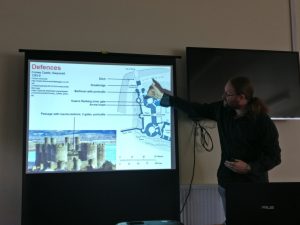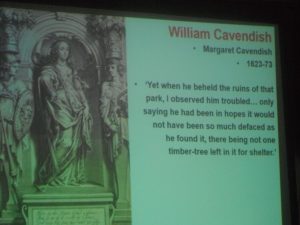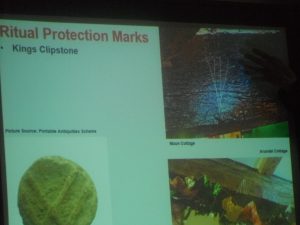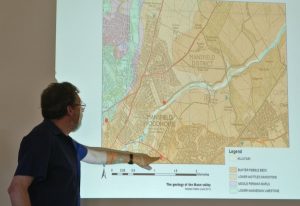- Strimming the nettles near the entrance
- Thinning out the self-set sycamores and other marked saplings
- Identifying and preparing spots for planing trees in November
- Clearing around the roses that we planted earlier this year
- Repairing dead-hedges along the boundary and around Ponds 0 and 1
- Using the grapple to remove woody debris from Pond 2
- Trimming the hawthorn at Spa Lane, widening the path, and other tasks associated with maintaining bridleway
Author: admin
Annual General Meeting: Saturday 1st September
Dear Member / Supporter of the Forest Town Nature Conservation Group (FTNCG),
I write to formally notify you of FTNCG’s rescheduled 2018 Annual General Meeting (AGM).
This meeting will be open to the public, and the formal business of the AGM will be followed by a short break and then a presentation and discussion about the fungi to be found at Spa Ponds with Ann Ward of the Nottinghamshire Fungi Group.
Date, time and place of the AGM:
Saturday 1st September 2018, from 10am at the Flint Avenue Community Centre (see attached directions).
General nature of business to be transacted:
1) Report and Accounts (including finance report / Annual Statement of Accounts)
2) Election of Officers and Trustees
Membership Renewal / Joining FTNCG:
The AGM will also provide a good opportunity to renew your FTNCG membership, or to join FTNCG (£5 suggested donation, waivable upon request).
Thank you for your ongoing support for the Forest Town Nature Conservation Group.
Yours sincerely,
Shlomo Dowen
Chair of the Forest Town Nature Conservation Group
https://www.foresttown.net/nature
See: Map to Flint Avenue Community Centre
Spa Ponds Work Session – Saturday 19th May, from 10am
Hello All
Please join us at Spa Ponds for our next work session, starting at 10am on Saturday 19th May. Be sure to wear sturdy shoes and long sleeved shirts.
The plan is for Rich to be with us and he intends to help us identify some of the amazing wildflowers we have on the site. We will also be progressing with the preparations for planting as part of the Wetland Habitat Recreation Project, e.g. by clearing bramble near Pond 1.
Facebook event: https://www.facebook.com/events/167317630623102/
FTNCG AGM postponed (and other news)
Hello again FTNCG Folk
I write to inform you that the Forest Town Nature Conservation Group (FTNCG) Annual General Meeting (AGM) scheduled for Saturday 28th April has been cancelled. We will arrange a new date and let you know in plenty of time…
In addition to this Saturday evening’s toad count (from 8pm at Spa Ponds) we are also looking forward to some daytime work sessions.
The next work session planned for Spa Ponds will take place on Saturday 21st April, from 10am at the Clipstone Drive entrance.
Also, we anticipate organising a planting session at Spa Ponds as part of our Wetland Habitat Recreation Project. Sometime from Monday 23rd April onward, depending on EMEC collecting plants after being informed by NatureScape that they are ready for EMEC to collect. Watch this space (especially around Pond 1 and the start of Pond 2)…
Opportunities for more Heritage research and training with Matt Beresford are being planned for Thursdays in May (in particular Thursdays 3rd, 10th, 17th and 24th May). Details to follow…
Thanks again to everyone who continues to support FTNCG!
Planned FTNCG Activities (January – April 2018)
- Friday 26th January (1pm – 4pm) FTNCG Management Meeting at Flint Avenue
- Saturday 27th January (10am – 1pm) Spa Ponds Work Session
Saturday 10th February (10am – 1pm) Spa Ponds Work Session(UPDATE: CANCELLED DUE TO WEATHER)
- Friday 2nd March (10am – 2pm) FTNCG Management Meeting at Flint Avenue
- Saturday 3rd March Work Session from 10am at the Rushpool Open Space and then from 1pm at Spa Ponds (to be confirmed).
- Saturday 24th March (10am – 1pm) Spa Ponds Work Session
- Saturday 28th April 2018 from 10am FTNCG’s AGM at the Flint Avenue Community Centre, followed by a talk from Ann Ward about the various types of fungi found at Spa Ponds (to be confirmed).
- Saturday 27th January 2018 from 10am – 1pm
- Saturday 24th March 2018 from 10am – 1pm
- Friday 26th January 2018 from 1pm – 4pm at the Flint Avenue Community Centre
- Friday 2nd March 2018 from 10am – 2pm at the Flint Avenue Community Centre
Account of 7th July 2017 Mediaeval Landscape Day School
The Spa Ponds Heritage Project was established to investigate, celebrate and protect the heritage of Spa Ponds Nature Reserve in Forest Town, Mansfield, and is supported by a Heritage Lottery Fund Sharing Heritage grant of £8,500.
On Friday 7th July 2017 James Wright delivered a Mediaeval Landscape Day School for the Spa Ponds Heritage Project. Shlomo and Josh’s account of the day is below:
The Day School was entitled: ‘Kings, Knights and Knaves of Clipstone – A Day School Exploring The Mediaeval Landscape of Sherwood’, which was a fitting title, as author and archaeologist James Wright provided participants with a four-in-one treat in the form of a comprehensive Day School that featured:
- A seminar exploring the definition of a castle;
- A lecture focusing on elite landscapes;
- An engaging seminar about Mediaeval hunting; and
- A lecture that looked at the theme of revolt against authority in the 14th and 17th centuries at Clipstone.
Seminar – What is a castle?

Spa Ponds sits within, or alongside, the Mediaeval context of Clipstone Peel, a fenced enclosure on the edge of Clipstone Park. Our knowledge of the peel site from Mediaeval sources and modern analysis of the political situation at the time indicate that the peel was intended, at least in part, to provide a secure location for the king to reside during a time of political strife (in particular King Edward II’s ongoing feud with Thomas, Earl of Lancaster). Because of this, Clipstone Peel shared many features and purposes in common with medieval castles.
We began the day by identifying some of the castles that we had visited, and James impressed us all with his intimate knowledge of so very many castles. This was the prefect start to our consideration of the basic but tricky question: “What, pray tell, is a castle”?
For example, the building at Bolsover has been rebuilt – is it still a castle? And what of the construction at Disneyland – although it is clearly an attempt to reflect an archetypal castle – does it meet the definition of a castle? What qualities need to be present for a structure to constitute a ‘castle’?

James noted that castles are built for not by royalty and others. We discussed who commissioned castles to be built and we generated a list that included: kings and queens; other royalty (such as dukes, barons, gentry, and other aristocrats, e.g. in Wales); and other landowners, including magnates (e.g. Henry Percy), statesmen (e.g. Ralph Cromwell); knights; The Church and associated religious orders and bishops, e.g. fortified structures at priories, and Newark Castle (Alexander the Magnificent was a bishop). Vikings built fortifications for their armies, crusaders built castles, and some castles built for wealthy merchants, e.g. Lawrence de Ludlow.

We went on to consider the sorts of buildings and rooms and architectural features found in castles, and how many of these are reflected in contemporary buildings to this day. All these considerations helped frame the tricky question: Are castles built primarily for military purposes or to provide a residence, or both? We identified plenty of non-military uses of castles, thus ruling out the notion that castles are (or were) exclusively built for military purposes, even if they inevitably reflect “an architecture of power”.

Lecture – Elite Landscapes: Beyond the Castle Gate
James’ lecture on elite landscapes drew our attention to the deliberate relationship between windows, nearby gardens, and the larger landscape context (park land) that can be seen further afield. James pointed to the religious influences, whilst noting that castles were sometimes but not always located near churches.
We learned about the classic motte-and-bailey castle design, with James explaining that a motte is a mound of earth and a bailey is an enclosure. Castles are located at high points in the landscape, e.g. Bothamsall on Castle Hill on a former Saxon enclosure with the motte in the middle.

The building of a castle sometimes required the clearing of woodland to create lawns (including deer lawns). The landscapes within which castles are located include both functional and symbolic elements. Good landscape management was associated with good management of the kingdom as a whole.
The royal hunting land of Clipstone Park was thought to have been a key part of the visual and symbolic landscape of King John’s Palace, known as the King’s Houses, with the ‘wilderness’ of the forest contrasting with the more managed gardens of the palace complex.
Seminar – An examination of Mediaeval hunting with reference to Sir Gawain and the Green Knight

James’ creative approach to teaching made use of poetry, in particular selected passages from Simon Armitage’s contemporary translation of Sir Gawain and the Green Knight, to help us appreciate what went on at deer parks, such as the one at Clipstone Park. Again the symbolism was apparent, with lording it over the deer and lording it over the landscape representative of the ruler’s power – hence the association between hunting and the aristocracy.
Participants were split into several small groups to facilitate our close consideration of James’ carefully selected excerpts from Sir Gawain and the Green Knight. This process introduced us to a series of fairly gruesome words and images, such as “numbles” (entrails), “gralloching” (disembowelling), and other terms associated with the ritual butchering of deer killed in the hunt.
It became abundantly clear that the many rituals and customs associated with Mediaeval hunting served to reinforce the social order. For example, social status determined which cuts of meat were given to whom, with the hunting dogs shown preference over and above the local villagers. There was also evidence of superstition, such as the reference to paying a ‘fee for the crows’.
Whilst aristocratic hunting was not a very practical means of gathering food, in addition to its social function it did also serve the additional purpose of helping to train horses and men to be better prepared for warfare. The hunting techniques employed required planning, coordination between participants, and the ability to function on difficult and noisy terrain.
Lecture – Royalty, Rebellion and Revolution in Sherwood Forest
James’ lecture entitled ‘Royalty, Rebellion and Revolution in Sherwood Forest’ looked at the theme of revolt against authority in the 14th and 17th centuries at Clipstone. The 14th century focus was on Edward II, the peel and Robert de Clipstone. The 17th century focus was on revolution, recusants and witches. A recusant is a person who refused to attend services of the Church of England.
James noted that the first written record of the Kings Houses at Clipstone being described in as “King Johns Palace” was Chapman’s map of Nottinghamshire (1774).
Edward II had a great love of hunting, and timed his visits to Clipstone to correspond with deer hunting seasons. He was not universally respected, as he was seen as weak. Edward II lost the Battle of Bannockburn to the Scots in June 1314, and his power was diminished by this defeat. This added to his problems with Thomas, Earl of Lancaster.

Edward II’s ban on tournaments was described as another sign of his weakness, as Edward II needed to maintain control during his turbulent reign. This adds to the notion that Edward II had the peel (fortified structure) at Clipstone built as both a defence (against Thomas, Earl of Lancaster) and to provide Edward II with a place to hide if need be. There is some evidence that Edward II stayed at the Peel rather than the Kings Houses in order to be safer from Thomas, Earl of Lancaster.


Edward II may have fled the country, despite reports that he was murdered in Berkeley Castle. Whatever the case, it is universally accepted that Edward II was forced to relinquish his crown in January 1327, when his fourteen-year-old son, Edward III, became king (at least in name). It is thought that the true power during the start of Edward III’s reign was his mother Isabella and her lover Roger Mortimer.
The turbulence of these times may help explain the boldness of the local people who rose up to petition the King to return to them the land rights that were taken away when the Peel was erected and lands taken for the King for the Peel and adjacent farmland. Robert de Clipston is recorded as having been one of the original petitioners in relation to the peel was also the “keeper of the manor and park of Clipston” in 1328, when the Peel was dismantled early in the reign of Edward III. Some of the disputed land might have included the area we now know as Spa Ponds.


A full account of the petitioning and subsequent throwing down of the Peel is included within Jame Wright’s “A Palace For Our Kings“.

In the 17th Century there was a spike in the number of recorded recusants (i.e. those not attending church and instead submitting to the authority of the Pope) and an apparent increase in the number of ritual protection marks, reflecting the social tensions of the times.
There is the possibility that Beeston Lodge was named after the family of Thomas Beeston Senior who was a Nottinghamshire yeoman and 17th century recusant.


MORE ABOUT JAMES WRIGHT
James Wright FSA is an archaeologist and historian who is currently a doctoral researcher at the University of Nottingham With over twenty years of professional experience, he has published two books and a string of popular and academic articles concentrating on the British Mediaeval and Early Modern periods. He is a very proficient public speaker and has spoken to a wide variety of organisations including a large number of local history societies, LAMAS, Thoroton Society, WEA, Thames Discovery Programme, Nottinghamshire Local History Association, U3A, Lowdham Book Festival and the Fortean Society. He has also been invited to speak by the University of Nottingham, Gresham College, Shakespeare, Museum of London, Historic Royal Palaces and the National Trust. He presents in a clear and conversational style (without notes or script) and readily uses illustrative slides throughout his lectures. The talks are adaptable and can be presented to novice, mid-level or expert audiences.
For yet more, see: http://nlha.org.uk/news/james-wright/ and http://www.triskelepublishing.com/jameswright/
Account of 17th June 2017 Reading the Landscape Workshop
On Saturday 17th June 2017 Stephen Walker delivered the Reading the Landscape Workshop for the Spa Ponds Heritage Project. Shlomo and Josh’s account of the day is below:
To help us think at a ‘landscape scale’ Stephen began by introducing us to the various ways that geomorphic processes influence creation of landforms and shape the planet earth. A representation of the landscape and geology is seen in the geological memoirs and we were shown a diagram of the geology of our area (Source: Edwards, W.N, ‘The geology of the country around Ollerton’, (HMSO, 1967) – see page 2 (Plate 1) of http://pubs.bgs.ac.uk/publications.html?pubID=B01568). This demonstrated how the beds of rock slope from west to east (called the ‘dip’ of the rocks) and showed the different layers of rock that form the valleys and hills around Spa Ponds. The Maun follows the dip of the rocks as it makes its way from west to east towards the Trent.


Next he introduced us to the rocks which underlie our part of the Maun valley. Terminology has changed over the years, so we agreed to use the traditional names applied to the rock layers. The Bunter Sandstone (also known as ‘Nottingham Castle Sandstone’) is youngest and nearer the surface, whereas Lower Mottled Sandstone (also known as ‘Lenton Sandstone’) is older and lower down. It is also softer and more easily eroded. We were also introduced to ‘Marl’ which is clay rock rich in lime. Importantly, Marl does not allow water to pass through. This means that any water in the sandstone that is between two layers of Marl will be trapped unless it finds a way out.
Stephen showed us photographs he took in Mansfield of different geological layers:




This portion of the presentation was followed by a group discussion about influences on the landscape at Spa Ponds. Such influences included:
- Slopes on either side directing water towards the ponds as well as causing erosion
- Different geological layers of sandstones and marl possibly giving rise to the underground springs
- Changes to the landscape resulting from human activity, e.g. mining and subsidence (and mine water changing water table level)
- Construction of ponds (ancient and modern)
- Changing path of river for flood dykes (in both 13th and 19th centuries)
- Planting of trees (including pine)
- Run-off from nearby farms
- Localised flooding (flash floods)
- Animals using the River Maun (including dogs causing erosion when/exiting the water over damp river banks)
Arising from the discussion, Stephen explained how water flowed over the surface and sometimes through the rocks and soil. The interrelationship between the sandstone layers which are permeable (allow water through) and the scattered marl beds which are impermeable (don’t allow water through) is the likely cause of the springs which feed Spa Ponds.

Discussions moved on to include ideas for mapping of springs and ponds in the vicinity of Spa Ponds to help us understand the setting. Also discussed was measuring the time it takes between weather events, e.g. rainfall, and observable changes to the water flow between the ponds and/or the water level in the ponds/river.

Next Stephen treated us to an explanation of the impacts of the Anglian and Devensian Ice Ages in this area. He noted how one effect of glaciation was that the River Trent was diverted because of melting glaciers. This is relevant to Spa Ponds as the River Maun flows towards the Trent. It is safe to assume that the area we know of as Spa Ponds would have been completly covered by ice during the earlier Anglian Ice Age because Anglian deposits are found nearby. However, this area would have been on the edge of the ice sheets during the Devensian Ice Age. The valley that includes Spa Ponds could have been formed in the interglacial (warm) period between the Anglian and Devensian Ice Ages.
The Anglian and Devensian periods are the geological terms for what archaeologists call the stone age. It is likely that there were people in this landscape. At Farndon (in the Trent Valley) the ‘Ice Age Journeys’ project has been investigating stone age hunting camps, so it is possible that the hunters also passed along the Maun valley.

Stephen introduced us to the term ‘periglacial’ (meaning ‘on the margins of a glacier’), explaining how Spa Ponds would have been part of an environment that was on the edge of a glacial environment, meaning that water on the land would freeze and then thaw repeatedly to cause weathering. In summer, meltwater would flow across the frozen subsoil (permafrost) just as it does in Siberia today. Seasonal streams charged with meltwater flowing over the frozen ground could have created valleys which now have no surface streams, (and are known as ‘dry’ valleys). This proposition is supported by the LiDAR evidence of ‘side valleys’ and what Stephen described as the Dendritic drainage pattern (see photo above).

Alternatively, Stephen explained how limestone is eroded into caves by underground water and how in some areas along the Maun such caves have collapsed to create valleys.
Stephen then offered us a series of questions to help us focus on what we know and what we might wish to know about the Spa Ponds landscape. He also posed the following three important questions to help us decide our next steps:
- What are our research priorities?
- What help and resources are required?
- What are the management implications?
Some ideas arising in response to these questions included:
- Consider what we might learn from the Ice Age Journeys project
- Explore the implications of artesian basin for water pressure and the relevance to the underground springs at Spa Ponds
- Contact Dr Andy Howard, who is an expert in periglacial research, to discuss periglacial influences on Spa Ponds
- Find out more about water table level monitoring held by the Environment Agency
- Undertake a longitudinal (long section) study of Spa Ponds to determine the height of the ponds
- Focus core sampling efforts on Pond 0 (Fern Gulley) and Pond 1
- Measure the water flow and compare results with those recorded by Tony Davison (in 1995)
- Find out more about historic landfilling in and around Spa Ponds
- Map and analyse nearby springs to determine if they are at the same level as spa Ponds, as this could indicate that the springs are related to the underlying strata, in particular the clay partings
- Locate nearest brick pits to help answer the question about where the clay (used to line the ponds) might have originated
- Research local mining history as it relates to mine water, subsidence, etc., including checking with the Coal Board to see if they have records of pumping / water table (e.g. around Clipstone Colliery) and borehole data from test holes and shafts sunk (to help identify sandstone and marl layers in and around Spa Ponds)
Formal notice of FTNCG AGM (5th July 2017)
– Review of the past year (Shlomo, Chair)
Community Archaeology at Spa Ponds – Book your place today!
1) Monday 12 June – Packman’s Way cross-section surveys & Deer Park recording2) Tuesday 13 June – Pond ‘0’ (‘Fern Gully’) survey3) Thursday 15 June – Field Visit: Scarcliffe Park (an example of a deer park)4) Tuesday 20 June – Geophysical survey5) Thursday 22 June – Peel and ‘scoop/pit’ recording
Event on 1st April to share memories of Gara Ponds
Please come along and bring some friends to the special session arranged for Saturday 1st April at the Flint Avenue Community Centre where photographs and memories of Gara Ponds will be discussed.
Those interested in taking part are welcome to drop in at any time from 10am – 3pm (see attached poster). Refreshments and friendly conversation will be available.
This event is supported by the Heritage Lottery Fund as part of a project that involves researching and celebrating the 700 year history of the ponds which were once owned by kings and dukes and which are now owned by the community.
If you would like directions to the Flint Avenue Centre please contact event organiser Shlomo Dowen on spa.ponds@gmail.com
You can also visit the Facebook Event at https://www.facebook.com/events/404151079952210/
A map showing how to get to Flint Avenue Community Centre is at https://www.foresttown.net/heritageproject/Flint_Avenue_Community_Centre_Map.pdf
